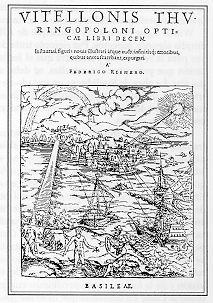Vitello

Vitello (Polish: Witelon; German: Witelo; c. 1230 – 1280/1314) was a Polish friar, theologian, natural philosopher and an important figure in the history of philosophy in Poland.
Name
[edit]Vitello's name varies with some sources. In earlier publications he was quoted as Erazmus Ciolek Witelo, Erazm Ciołek, Vitellio and Vitulon. Today, he is usually referred to by his Latin name Vitello Thuringopolonis, often shortened to Vitello.
Life
[edit]Vitello's exact birth-name and birthplace are uncertain. He was most likely born around 1230 in Silesia, in the vicinity of Legnica.[1] His mother came from a Polish knightly house, while his father was a German settler from Thuringia. He called himself, in Latin, "Thuringorum et Polonorum filius" — "a son of Thuringians and Poles." He studied at Padua University about 1260, then went on to Viterbo. He became friends with William of Moerbeke, the translator of Aristotle from Greek language into Latin. Vitello's major surviving work on optics, Perspectiva, completed in about 1270–78,[2] was dedicated to William. In 1284 he described the reflection and refraction of light.[3]
Perspectiva
[edit]
Vitello's Perspectiva was largely based on the work of the polymath Alhazen (Ibn al-Haytham; d. ca. 1041) and Robert Grosseteste, and he in turn influenced later scientists, in particular Johannes Kepler. Vitello's treatise in optics was closely linked to the Latin version of Ibn al-Haytham's Arabic opus: Kitab al-Manazir (The Book of Optics; De aspectibus or Perspectivae), and both were printed in the Friedrich Risner edition Opticae thesaurus (Basel, 1572).[4]
Vitello's Perspectiva, which rested on Ibn al-Haytham's research in optics, influenced also the Renaissance theories of perspective. Lorenzo Ghiberti's Commentario terzo (Third Commentary) was based on an Italian translation of Vitello's Latin Perspectiva.[5]
Vitello's treatise also contains much material in psychology, outlining views that are close to modern notions on the association of ideas and on the subconscious.
Perspectiva also includes Platonic metaphysical discussions. Vitello argues that there are intellectual and corporeal bodies, connected by causality (corresponding to the Idealist doctrine of the universal and the actual), emanating from God in the form of Divine Light. Light itself is, for Vitello, the first of all sensible entities, and his views on light are similar to those held by Roger Bacon, though he is closer in this to Alhazen's legacy.[6]
Other works
[edit]In Perspectiva, Vitello refers to other works that he had written. Most of these do not survive, but De natura daemonum and De primaria causa paenitentiae have been recovered.
Legacy
[edit]The lunar crater Vitello is named after him.
See also
[edit]Notes
[edit]- ^ Haisig, Marian (1977). Legnica, monografia historyczna miasta (in Polish). Poland: Ossoliński. p. 77.
- ^ CHAUCER NAME DICTIONARY Copyright © 1988, 1996 Jacqueline de Weever Published by Garland Publishing, Inc., New York and London.
- ^ Joe Rosen; Lisa Quinn Gothard. Encyclopedia of Physical Science. Infobase Publishing; 2009. ISBN 978-0-8160-7011-4. p. 691.
- ^ Nader El-Bizri, "A Philosophical Perspective on Alhazen's Optics", Arabic Sciences and Philosophy, Vol. 15, Issue 2 (2005), pp. 189-218 (Cambridge University Press)
- ^ Graziela F. Vescovini, "Contributo per la storia della fortuna di Alhazen in Italia: II volgarizzamento del MS. Vat. 4595 e il Commentario terzo del Ghiberti, Rinascimento, V (1965), pp. 1749 -- Also (Ibid, El-Bizri, 2005)
- ^ Ibid, El-Bizri, 2005
References
[edit]Vitello and his thoughts
- Witelonis Perspectivae Liber Primus: Book I of Vitello's Perspectiva, edition and English translation by Sabetai Unguru, with introduction and commentary, Warsaw, The Polish Academy of Science Press, Studia Copernicana, vol. XV, 1977.
- Witelonis Perspectivae Libri Duo - Liber Secundus et Liber Tertius: Books II and III of Vitello's Perspectiva, edition and English translation by Sabetai Unguru, with introduction and commentary, Warsaw, The Polish Academy of Science Press, Studia Copernicana, vol. XXVII, 1991.
- Witelonis Perspectivae Liber Quartus: Book IV of Vitello's Perspectiva, A Critical Edition and English Translation with Introduction, Notes and Commentary by Carl J. Kelso, University of Missouri-Columbia, 2003.
- Witelonis Perspectivae Liber Quintus: Books V of Vitello's Perspectiva, edition and English translation by Mark A. Smith of the First Catoptrical Book of Witelo's Perspectiva, with introduction and commentary, Warsaw, The Polish Academy of Science Press, 1983.
Studies
- Clemens Baeumker, "Witelo: Ein Philosoph und Naturforscher des dreizehnten Jahrhunderts," Beiträge zur Geschichte der Philosophie des Mittelalters, part 3, no. 2, Münster, Aschendorff, 1908.
- Władysław Tatarkiewicz, Historia filozofii (History of Philosophy), 3 vols., Warsaw, Państwowe Wydawnictwo Naukowe, 1978.
- Jerzy Burchardt, "The Discovery of the Rainbow in Crystal by Witelo"
External links
[edit]- Online Galleries, History of Science Collections, University of Oklahoma Libraries High resolution images of works by and/or portraits of Witelo in .jpg and .tiff format.
- Erasmus Ciołek Witelo monument in the Żórawina village, Wrocław County, Lower Silesian Voivodeship, SW Poland. [1]
- People from Silesia
- Polish historians of philosophy
- Natural philosophers
- 13th-century mathematicians
- Catholic clergy scientists
- 13th-century Polish historians
- Polish Roman Catholic theologians
- Medieval Polish scientists
- Polish philosophers
- Medieval Polish mathematicians
- 13th-century German scientists
- German physicists
- Canons of Wrocław
- 13th-century German writers
- Medieval German mathematicians
- 13th-century writers in Latin
- People from Legnica
- Scholastic philosophers
- 1280 deaths
- 13th-century Polish clergy
- University of Padua alumni
- 13th-century German philosophers
